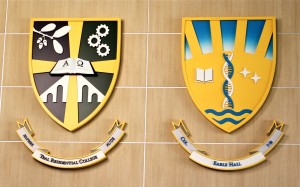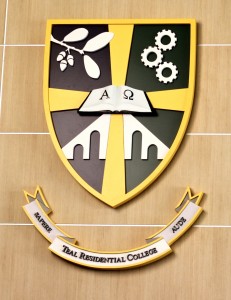 We promised earlier this fall that we would go into more detail about the symbolism of the elements of the crests representing both Hallie Earle Hall and Gordon Teal Residential College in Baylor’s new East Village Residential Community.
We promised earlier this fall that we would go into more detail about the symbolism of the elements of the crests representing both Hallie Earle Hall and Gordon Teal Residential College in Baylor’s new East Village Residential Community.
Each residential facility is named for an important contributor to science. Dr. Hallie Earle (1880-1963) became the first female graduate of Baylor Medical School in Dallas. She later served as the first licensed female physician in McLennan County history.
A member of the Inventors Hall of Fame, Gordon Teal (1907-2003) graduated from Baylor in 1927 with a degree in math and chemistry. He was instrumental in developing the first silicon transistor while working at Texas Instruments – an invention that revolutionized the electronics industry.
Baylor students played an integral part in designing the crests for both Earle Hall and Teal Residential College. The symbols in each crest are explained below, in text taken from each facility’s website.
Hallie Earle Hall
 DNA Strands: These two strands represent the close relationship between science and medicine. One cannot flourish without the other. There are 15 bonds holding the DNA strands together and there are 15 columns in the Baylor Sciences Building. These two complimentary DNA strands symbolize the deep connection between our two buildings and among the students that fill our classrooms. The bonds of friendship and camaraderie that our students will develop are critical for the integrity of our community, much like the bonds between the strands of DNA are critical for the integrity of the molecule. The DNA strands are rising from the water, which is another important symbol in our crest.
DNA Strands: These two strands represent the close relationship between science and medicine. One cannot flourish without the other. There are 15 bonds holding the DNA strands together and there are 15 columns in the Baylor Sciences Building. These two complimentary DNA strands symbolize the deep connection between our two buildings and among the students that fill our classrooms. The bonds of friendship and camaraderie that our students will develop are critical for the integrity of our community, much like the bonds between the strands of DNA are critical for the integrity of the molecule. The DNA strands are rising from the water, which is another important symbol in our crest.
Water: As Jesus washed the disciples’ feet, taking the role of a servant, the water symbolizes the servant leadership of our students. They will serve the community and each other with justice, compassion and honesty. Water also represents cleansing, a new beginning. It is important to notice that it also alludes to the lazy river in front of the Sciences Building, highlighting again the close relationship between our two buildings.
Dayspring: “Through the tender mercy of our God, whereby the dayspring from on high has visited us” (Luke 12:78). As the day breaks, the darkness is cast aside to show the promise of a new day. The four rays of sunlight are reminiscent of the four Baylor columns still standing proud in Independence, Texas, where our University had its humble beginnings. The dayspring (sunrise) is the foundation of East Village and it marks a new beginning for our students as they embark in their studies.
Book: There are many possible meaning for a book. Books represent knowledge, leadership, guidance, and education; if the book is the Holy Bible then it also represents our faith and trust in God. We want to develop in our students a strong desire to learn, to be scholars and we want them to do it in a manner pleasing to God. We want them to proudly share their knowledge on both science and faith with others.
Stars: Two four-pointed stars are part of the Earle Hall crest, one point for each of the eight departments that will come together under our roof: biology, chemistry and biochemistry, psychology and neuroscience, medical humanities, nursing, communication disorders, nutrition, and health, human performance and recreation (HHPR). Together we will form a community that values each other and we will help each other achieve our full potential without envy or resentment.
Gordon Teal Hall
 The symbols, words and colors on the crest for Teal Residential College were selected from student designs submitted during the spring semester of 2012. At a subsequent public viewing, students and faculty commented on the designs and the graphic elements in each one. Based on these comments, junior electrical engineering student Jessica Siler drafted the final design, which was digitally rendered by the architectural firm for East Village.
The symbols, words and colors on the crest for Teal Residential College were selected from student designs submitted during the spring semester of 2012. At a subsequent public viewing, students and faculty commented on the designs and the graphic elements in each one. Based on these comments, junior electrical engineering student Jessica Siler drafted the final design, which was digitally rendered by the architectural firm for East Village.
Prominently featured in the center of the crest is an open book, a thematic element common to the crests of Baylor’s residential colleges. Referencing Revelation 22:13, Alpha and Omega signify the mission of TRC to be a “Christ-centered fellowship” from the beginning to the end.
The structure near the bottom of the crest is reminiscent of the designs of ancient bridges and aqueducts, representing some of the earliest engineered structures. Its six pillars correspond to the days of the biblical creation account and symbolize the creative aspects of the practices of engineering and computing, the academic disciplines of most TRC residents. The bridge connects Truth (blue) with Hope, Joy and Love (green) through the cross that subdivides the crest.
The upper right quadrant shows three gears, signifying the three academic departments within the School of Engineering and Computer Science at the opening of TRC in 2013. Each gear has 11 teeth, marking the date, November 2011, when construction was approved by the Baylor Board of Regents. Together, the 33 teeth represent the span of time from 2013 back to 1980, when the “Department of Engineering and Computer Science” was formed at Baylor University.
The oak leaves and acorns in the upper left quadrant signify strength and wisdom, in accordance with the TRC mission to foster the “pursuit of wisdom.” They illustrate a live oak branch, which is the most common type of oak tree in central Texas.
Proclaiming sapere aude (dare to know), the banner urges the members of TRC to be men and women of strong faith and sound reason, emulating the community namesake Gordon K. Teal.
A Baylor graduate with degrees in mathematics and chemistry, Dr. Teal is widely recognized for his contributions to the development of the monocrystalline silicon P-N junction, which made possible the first commercially viable silicon transistors and opened the floodgates of innovation in electronics and computing. Astute observers will note a stylized schematic of the P-N junction in the crest, honoring the life and work of Dr. Teal.
